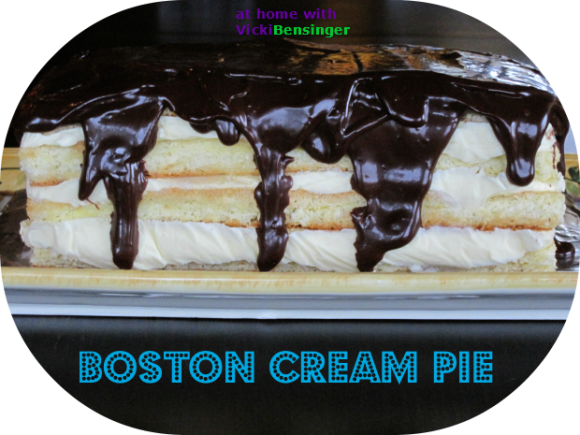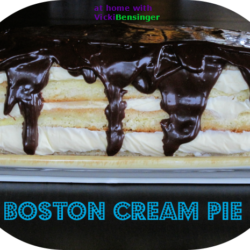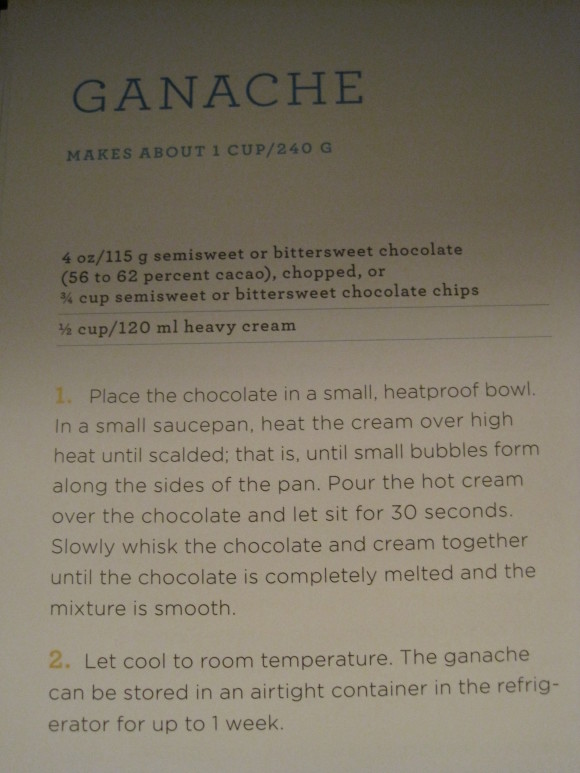Boston Cream Pie

Both of my kids celebrate their birthdays in August. I asked my son (27) what cake he wanted me to make and he chose my Mile High Carrot Cake. My daughter (24) on the other hand fell in love with Boston Cream Pie while going to school in Boston and selected that. You might recall my post about Mike’s Pastry Shop in Boston where we both did some serious indulging while I spent a long weekend there.
I’d never made Boston Cream Pie before, but since my little girl wanted it, I would make that for her, and the carrot cake for my son.
Boston Cream Pie isn’t really a pie. First served in 1856 in the Parker House hotel in Boston, now known as the Omni Parker House, it’s actually a vanilla sponge cake filled with pastry cream and topped with a chocolate glaze.
I remembered seeing a recipe for Boston Cream Pie in Joanne Chang’s “flour, too” cookbook . Joanne has a cafe and bakery in Boston as well. I reviewed the recipe at least 16 times, reading it over and over again. It was so detailed I was afraid I’d leave something out. Joanne’s version is a slightly lighter adaptation of the original Boston Cream Pie.
Joanne’s wording although detailed, did leave some room for interpretation which could make the difference from a wonderful cake, to a flop. For instance, the sponge cake calls for 4 eggs, separated, plus 3 egg whites. My take on this was to use 4 egg yolks with 7 egg whites. However, when my daughter and I went to make the cake (she wanted to help), she insisted I was wrong. I went online to see if I could find Joanne’s Boston Cream Pie recipe with comments, low and behold Joanne commented on this site that the recipe was as I had predicted. Obviously others had their doubts. I’m glad we checked.
There are 14 steps in this recipe, although within those steps it also calls to make a Pastry Cream, and Chocolate Ganache, requiring you to view other pages in the cookbook for those recipes. This is quite detailed.
I decided to spread the recipe out over 3 days, especially since we are still vacationing in the mountains and had other plans on our agenda. I’m glad I did, however, when I make this again, I will spread it out over 4 days before serving. Why?
The sponge cake has coffee flavored syrup that is brushed over the top, then each layer is filled with the pastry/whipped cream combination. At this point it’s placed in the freezer overnight. Three hours before serving, the cake is removed from the freezer, and the chocolate ganache is poured over the top, then left out to thaw.
We left and went out for a birthday dinner. Upon our arrival we lit the candles on both cakes, and had a slice of both the carrot cake and Boston Cream Pie. The Boston Cream Pie had such a strong coffee flavor none of us could eat it. I was so disgusted as you can imagine, since this cake took so long to prepare. BUT WAIT!
My first thought was to just pitch the cake realizing no one would eat it. I decided to hold off, covered it in plastic wrap, and placed it in the refrigerator. I thought, I’ll try it tomorrow just in case we disliked it merely because we were all so stuffed from dinner.
That next day after lunch I decided to try a small slice. OMG! I couldn’t believe it. The Boston Cream Pie had no hint of coffee flavoring at all. Now mind you we love coffee, except my husband, but it was as though it seeped into the cake overnight after having thawed and was delicious! I had to be sure my taste buds weren’t playing a trick on me, so asked my family to try another slice. They agreed, the coffee flavor was gone and they loved it. What a relief!
I was so thrilled with the outcome, especially with the amount of effort that went into this cake. So to add to Joanne Chang’s recipe:
After pouring the chocolate ganache over the frozen cake – leave cake out for 3 hours to thaw. Then cover with plastic wrap and place in the refrigerator for another 24 hours. Remove from the refrigerator and serve.
Here’s the recipe:

Boston Cream Pie
Ingredients:
- 4 large eggs, separated, plus 3 egg whites
- 1 cup granulated sugar
- 2 tablespoons freshly squeezed lemon juice
- 3/4 cups all-purpose flour
- pinch kosher salt
- 1/3 cup hot brewed coffee
- 1/3 cup granulated sugar
- 1 cup heavy cream
- 1 3/4 cup Pastry Cream (see separate recipe)
- 1 cup Ganache (see recipe below), warmed

Directions:
- Special equipment: 13- by 18-inch rimmed baking sheet, parchment paper, stand mixer with whisk attachment or handheld mixer, sifter or sieve, offset spatula, clean cardboard.
- To make the sponge cake: Preheat the oven to 350°F/180°C, and place a rack in the middle of the oven. Line the baking sheet with parchment paper.
- Using the stand mixer or the handheld mixer and a medium bowl, beat together the egg yolks, 1⁄4 cup (50 g) of the sugar, and the lemon juice on high speed for at least 6 to 8 minutes if using the stand mixer or 10 to 12 minutes if using the handheld mixer, or until thick and doubled in volume. Stop the mixer once or twice and scrape down the sides of the bowl and the whisk to ensure the sugar and yolks are evenly mixed. Transfer to a large bowl and set aside.
- Clean the bowl and the whisk attachment or beaters (they must be spotless) and beat the egg whites on medium speed for 2 to 3 minutes with the stand mixer or 4 to 6 minutes with the handheld mixer, or until soft peaks form. The whites will start to froth and turn into bubbles, and eventually the yellowy viscous part will disappear. Keep beating until you can see the tines of the whisk or beaters leaving a slight trail in the whites. To test for the soft-peak stage, stop the mixer and lift the whisk or beaters out of the whites; the whites should peak and then droop. With the mixer on medium speed, add the remaining 3/4 cup (150 g) sugar very slowly, a spoonful or so at a time, taking about 1 minute to add all of the sugar. Continue beating on medium speed for another 2 to 3 minutes, or until the whites are glossy and shiny and hold a stiff peak when you slowly lift the whisk or beaters straight up and out of the whites.
- Using a rubber spatula, gently fold about one third of the whipped whites into the yolk mixture to lighten it. Then gently fold in the remaining egg whites. Sift the flour and salt together over the top of the mixture and fold in gently until the flour is completely incorporated. Pour the batter into the prepared baking sheet.
- Using the offset spatula, carefully spread the batter evenly to cover the entire baking sheet. Concentrate on spreading the batter toward the corners and edges of the pan. The center will be easier to fill once the edges are filled with batter. Don’t worry about the top being perfectly smooth; it is more important that the batter be spread evenly so that the cake is the same thickness throughout. Bake the cake for 18 to 24 minutes, rotating the baking sheet back to front about halfway through, or until the top is pale golden brown and springs back when pressed in the center with your fingertips and the cake doesn’t stick to your fingers. Let the cake cool in the pan on the wire rack for about 5 minutes.
- Line a large cutting board with parchment. Run a paring knife around the edge of the still-warm cake to release it from the sides of the baking sheet, and invert the cake onto the parchment. Carefully peel off the parchment and allow the cake to cool completely. Using a chef’s knife, cut the cake in half crosswise and then in half lengthwise. You should now have four cake layers, each about 5 1/2 by 8 inches. Cut the cardboard so that its dimensions are just slightly larger than the cake layer dimensions.
- To make the soaking syrup: In a small bowl, stir together the coffee and sugar until the sugar has dissolved.
- Using the pastry brush, brush the top of all four cake rectangles evenly with the soaking syrup, using up all of the syrup.
- Place one cake layer, syrup-side up, on the prepared cardboard rectangle. In a medium bowl, using a mixer or a whisk, whip the heavy cream until it holds very firm, stiff peaks. Fold in the pastry cream (see separate recipe) until well combined. Using the offset spatula, spread about one third of the cream mixture over the cake layer. There is a tendency for the cream to mound in the center, so be sure to spread the cream out to the edges of the cake. In fact, to make the best-looking cake possible, it is better if the cream layer is slightly thicker along the edge than in the center.
- Place a second cake layer, syrup-side up, on top of the cream layer and press down gently so the cake layer is level. Using the offset spatula, spread about half of the remaining cream mixture over the cake layer. Again, you want to spread the cream a bit thicker along the edge of the rectangle to prevent the final cake from doming.
- Place a third cake layer, syrup-side up, on top of the cream and press down slightly to level the cake. Using the offset spatula, spread the remaining cream mixture over the cake, again making it a bit thicker along the edges than in the center. Top the cake with the final cake layer, syrup-side up, and press down gently so that the top layer is flat. Lightly wrap the cake with plastic wrap, place in the freezer, and freeze for about 8 hours or up to overnight, or until it is frozen solid. (At this point, the cake can instead be put into the freezer just until it has firmed up and then it can be well wrapped and frozen for up to 2 weeks.)
- At least 3 hours in advance of serving, remove the cake from the freezer and place it on a cutting board. Using a chef’s knife dipped in very hot water, trim the edges of the cake so that they are neat and even. (These trimmings make for great snacking.) Dip and wipe the knife clean several times as you trim to make sure you get a neat, sharp edge on the cake. Trim the cardboard underneath so it is flush with the cake.
- Place the cake on its cardboard base on a cooling rack set on a baking sheet. Pour the warm ganache (see separate recipe) over the top of the cake. Using the offset spatula, spread the ganache in an even layer. It will begin to firm up right away when it hits the cold cake, so work quickly to even the surface. Let the excess ganache drip down the sides of the cake, leaving some parts of the cake exposed. Let the ganache set for several seconds, then transfer the cake to a serving plate. Let the cake thaw at room temperature before serving.
flour, too
By Joanne Chang
Enjoy!!!